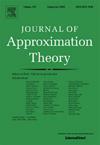迭代熵导数和二元熵不等式
IF 0.6
3区 数学
Q2 MATHEMATICS
引用次数: 0
摘要
我们对xk−rH(xr)的(k+1)阶导数进行了系统的研究,其中H(x)是−xlogx−(1−x)log(1−x)的二进制熵,k≥r≥1是整数。我们的动机是推测的熵不等式αkH(xk)≥xk−1H(x),其中0<;αk<;1由泛函方程给出。k=2的情况是推动最近在并闭集猜想上取得突破的关键技术工具。我们将dk+1dxk+1xk−rH(xr)表示为有理函数、无穷级数和广义斯特林数的和。这使我们能够简化对实数k的熵不等式的证明,以表明相关多项式在区间(0,1)中只有两个实数根,这也使我们能够证明分数指数(如k=3/2)的不等式。这个证明提出了一个新的框架来证明多项式的和乘以多项式的对数的紧不等式,它将不等式转化为关于一个更简单的相关多项式的实根的陈述。本文章由计算机程序翻译,如有差异,请以英文原文为准。
Iterated entropy derivatives and binary entropy inequalities
We embark on a systematic study of the -th derivative of , where is the binary entropy and are integers. Our motivation is the conjectural entropy inequality , where is given by a functional equation. The case was the key technical tool driving recent breakthroughs on the union-closed sets conjecture. We express as a rational function, an infinite series, and a sum over generalized Stirling numbers. This allows us to reduce the proof of the entropy inequality for real to showing that an associated polynomial has only two real roots in the interval , which also allows us to prove the inequality for fractional exponents such as . The proof suggests a new framework for proving tight inequalities for the sum of polynomials times the logarithms of polynomials, which converts the inequality into a statement about the real roots of a simpler associated polynomial.
求助全文
通过发布文献求助,成功后即可免费获取论文全文。
去求助
来源期刊
CiteScore
1.90
自引率
11.10%
发文量
55
审稿时长
6-12 weeks
期刊介绍:
The Journal of Approximation Theory is devoted to advances in pure and applied approximation theory and related areas. These areas include, among others:
• Classical approximation
• Abstract approximation
• Constructive approximation
• Degree of approximation
• Fourier expansions
• Interpolation of operators
• General orthogonal systems
• Interpolation and quadratures
• Multivariate approximation
• Orthogonal polynomials
• Padé approximation
• Rational approximation
• Spline functions of one and several variables
• Approximation by radial basis functions in Euclidean spaces, on spheres, and on more general manifolds
• Special functions with strong connections to classical harmonic analysis, orthogonal polynomial, and approximation theory (as opposed to combinatorics, number theory, representation theory, generating functions, formal theory, and so forth)
• Approximation theoretic aspects of real or complex function theory, function theory, difference or differential equations, function spaces, or harmonic analysis
• Wavelet Theory and its applications in signal and image processing, and in differential equations with special emphasis on connections between wavelet theory and elements of approximation theory (such as approximation orders, Besov and Sobolev spaces, and so forth)
• Gabor (Weyl-Heisenberg) expansions and sampling theory.

 求助内容:
求助内容: 应助结果提醒方式:
应助结果提醒方式:


